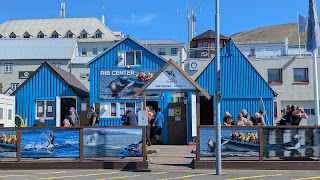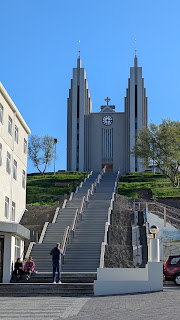One of the things an international visitor has to get used to in Iceland is the smell of water. While it is extensively advertised that tap water is perfectly safe to drink in the country, the smell of Sulphur, particularly in hot water, is difficult to get used to. It feels as if many rotten eggs have been mixed with the water. The water is pristine and perfectly potable, no doubt about that. But, it is the smell.
Last evening when I was checking into the guesthouse, Michael, who was at the reception, told me that the highest temperature last summer had been 22⁰C; today it was 27, the highest in recent times! People were fretting about the high temperature, while acknowledging that it was best for outdoor activities. This morning, too, the weather held up and provided the ideal environment for sightseeing.

The tariff of the Guesthouse included a buffet breakfast between 7.30 and 10 am. The Guesthouse complex has different types of accommodation. The one I was in had private living quarters on the ground floor and five guest rooms with shared toilets and showers, kitchen and living room on the second floor. The Guesthouse breakfast was quite adequate with cereals, breads, jams, cheese, butter, boiled eggs, salami, ham and beverages. I was keen to taste the bread made in the 'underground' bakery. Locals have been baking bread for centuries underground by harnessing the volcanic steam billowing out of the earth. Mývatn’s geothermal bakeries are a collection of holes dug a half meter into the ground and covered with wood, bricks and stones. The rye bread is called geysir bread. Geysir bread recipes are handed down through the generations, and each family apparently has its own. The geysir bread did taste very different, I didn't become a great fan of it.

Before breakfast I did some research on whale watching trips to decide the company and the location. I could either go for the tour from Husavik or Arskogsaandur. Husavik is known as the whale watching capital of Iceland. Therefore, I decided on the Gentle Giants company, that had been operating tours for over 150 years reportedly, from Husavik.
The first stop for the day was Grjotagja, small lava cave, located 15 km from the Guesthouse, on the way to Akureyri. The cave was the result of a fissure in the crust and has a history that added to its charm. Inside the cave is a hot spring consisting of calm, clear, blue water. The history of the cave dates back to the early 18th century when it was inhabited by Jón Markússon, an outlaw who had been ostracized from the local community. Following his death, locals used the thermal spring inside the cave for bathing. This was ended in the 1970s by the eruption of the Krafla volcanic system which to high temperature of the water making it unsafe.

Although the water cooled slightly over the years, the temperature is unpredictable and is therefore no longer safe for swimming or bathing. In Season 3, Episode 5 of Game of Thrones, Jon Snow and Ygritte visited this hidden gem together and introduced the world to its beauty. Since the episode was first aired in 2013, the cave became an extremely popular destination for many fans of the tv show, leading to excessive tourist arrivals and damage and vandalism. The cave was closed to the public by the owners of the private land for many years. The cave has jagged rocks and can be extremely slippery. Therefore, I took my time and carefully walked around, lest I drop into the waters of the cave!

From the awesome tour of the cave, I took the road to a waterfall, about 50 km away. The Godafoss waterfall is one of the most spectacular waterfalls in Iceland. The water of the river Skjalfandafljot falls from a height of 12 meters over a width of 30 meters. The ring road goes past the waterfall, with parking available on both sides of the river. There are paved walking paths to viewing platforms. The history of the waterfall is connected to the conversion of Icelanders to Christianity, when the idols of the Old Norse religion were thrown into the waterfall. And, from that stemmed the name of the waterfall, Godafoss.

Actually, Godafoss is a part of the Diamond Circle, which is a circuit of 250km in North Iceland. The circuit includes some of the most stunning sights and unearthly landscapes. The Diamond Circle has five key destinations, which include the historical and picturesque Godafoss, the unearthly blue and green landscapes of Lake Myvatn nature paradise, the uncontrollable white energy of Dettifoss, the most powerful waterfall of Europe, the crescent-shaped wonder of Asbyrgi canyon and Husavik, the buzzing whale watching capital of Iceland with the deep blue seas ahead.

From Godafoss my next target along the route to Akureyri was Husavik, to experience the whale watching tour. That was another 59 km away, towards the far north. When I arrived into Husavik, the place seemed quite busy, being the weekend. Moreover, the Husavik Wooden Church, almost bang opposite the waterfront, was having a funeral service. Considering the number of people, their apparent stations in life signified by their clothes and vehicles, and the swanky hearse, I surmised that the person who was to be laid to rest was an influential member of the Husavik society. The Husavik Wooden Church, built in 1907, looked every bit as magnificent as a newly built one.

It took me some time to locate a free parking lot, thanks to the gathering in the church. When I did, I walked a few minutes to the waterfront and located the booking office of Gentle Giants. A pleasant girl took my booking and gave me directions on where to report for the 1.15 pm wooden boat tour. The tour would last approximately 3 hours, she told me, as against the quicker speedboat tour. I had time on mybhands and that would save me some precious money too.
The capacity of the wooden boat, Faldur, the young lady guide said, is 45. It has a small viewing platform on top which can accommodate 6 persons at a time. At the time of boarding I counted less than 20 customers for the tour. All of us were given warm coveralls, which we were asked to wear before casting off into the Skjalfandi Bay. A few minutes into the ride and I was wet from head to toe from the sprays and it was cold, too. I moved to a spot in the boat where it was less crowded and protected from the unwanted showers.
The peak season for whale sighting is between May and September. On the tour, the sightings started about an about away from the shore. The guide kept up a lively commentary about the type of whales in the bay, whale habitat, diving habits, the peculiarity of its teeth formation and such like. A couple of humpback whales came up close and almost swam with us for a long time. Though the sightings were not within touching distance as is normally shown in tour photos, the fact that I could see so many dives made the tour worth its while and money.

The weather was good and that was a huge plus during the tour. All of us had certainly looked forward to the whales breaching and hopping. But none of that happened. We had to be content with the distinctive sounds it makes while surfacing and the dives. Anyway, I consoled myself that something is better than nothing. At the time of booking the girl at the counter told me that I would get a free lifetime voucher for another tour in case I was not able to see a sighting on this tour. That eventuality didn't arise, though.
Once the tour was done, I changed gears for Akureyri, which is about 75 km from Husavik. Akureyri is nicknamed the "Capital of North Iceland". It is an important port and fishing centre. The area has a relatively mild climate because of geographical factors, and the town's ice-free harbour has played a significant role in its history. It is said that Akureyri has been settled from the 9th century onwards.
I had booked the B4 Guesthouse in Akureyri. Unfortunately, within Akureyri town Google Maps played truant twice, before I called up the telephone number given in the booking voucher. With clear directions from the person at the other end I soon got to the parking in front of the guesthouse. It is a self-check-in facility. I lodged my belongings in the room and went out for a walk in the town, to imbibe the weekend spirit that was amply evident in the town center.
A small town or village is best explored on foot. Akureyri was no different. I took a stroll through the town centre, basically the Hafnarstaeti and Skipagata streets, stopping to look at a shop here, a cafe or a restaurant there. I got a bit acquainted with the roots of the town, walking through the old town and stopping by what I found arresting or fascinating. Such exploration will give you a glimpse of days gone by.

The second oldest part of Akureyri town is Oddeyri. The place is thought to have been settled in the 13th century, bit became part of teg town in the 19th century. The area is now home to Akureyri’s thriving seafood industry. There are several picturesque houses and buildings there too evoking the history of Akureyri. The Hof concert hall stands majestically beside the harbour. It has a lovely giftshop and a tourist information center, a perfect stop on your stroll along the water. At the time of my visit some kind of get-together was on, and people were out in the sun with glasses of wine and short eats.
Towering above the town center is the Akureyri Church. The Lutheran church, consecrated in 1940, was designed by the famous architect Samulesson and equally decorated sculptors have embellished the architecture and the added to the worshipful ambience of the church.
After the late evening stroll through the town, I sat down at the end of the Hafnarstaeti street near the I Love Akureyri sign, with the church looming right ahead of me. I spent a few moments in gratitude for the wonderful time I had been having in Iceland. While the weather forecast for the time I was to be there was gloomy when I set out from India, what I experienced in the country was totally different. The excellent weather had been a major factor in enjoying the drive through the country. The unseen hand guided me safely past many near misses and ensured that the choices I made were the best and for the best.

On the way to the guesthouse I grabbed a typical Icelandic hotdog, known as the pylsa. The specialty of the Icelandic hotdog is that it is made of lamb, pork and beef in a specific proportion and generously spruced up with finely chopped onions, crispy onions, mayonnaise, mustard and ketchup. I sat down in front of the roadside kisok and took in the awesome stuff as slowly as I could. I wanted the experience to last. It was indeed the icing on the cake, so to say, of the visit to the pretty town.























No comments:
Post a Comment